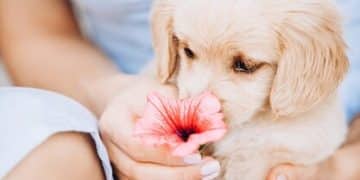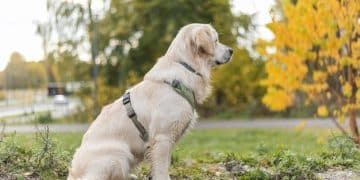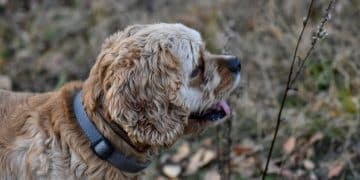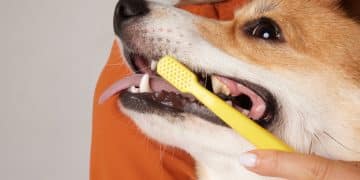Stop Puppy Biting Now: Your Comprehensive Guide to Bite Inhibition
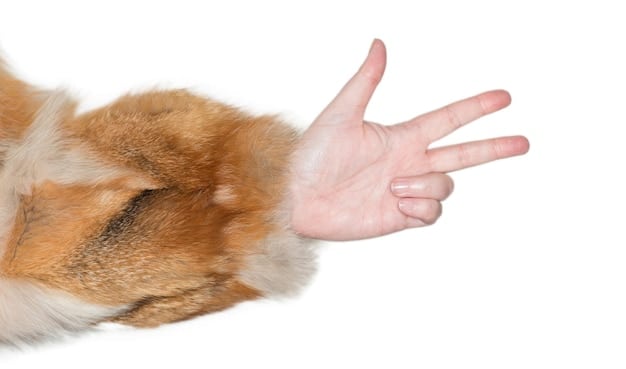
Anúncios
Stop Puppy Biting Now: The comprehensive guide addresses the reasons behind puppy nipping, provides effective training techniques to redirect this behavior, and emphasizes the importance of bite inhibition for a well-behaved and safe canine companion.
Bringing a puppy into your home is a joyous experience, but it often comes with its share of challenges. One common issue that many owners face is puppy biting. While it’s a natural behavior for young dogs, it’s crucial to address it early on. This article provides comprehensive strategies to stop puppy biting now: the ultimate guide to effectively teach bite inhibition and create a well-behaved, lovable companion.
Anúncios
Understanding Why Puppies Bite
Puppy biting is a normal part of their development. Like human babies, puppies explore the world with their mouths. Understanding the reasons behind this behavior is the first step in correcting it.
Teething
One of the primary reasons puppies bite is because they are teething. As their adult teeth push through, their gums become sore and irritated. Chewing and biting provides relief.
Anúncios
Exploration
Puppies use their mouths to investigate their surroundings. This is similar to how human babies explore the world with their hands and mouths.
Play
Biting is often a part of play behavior. Puppies nip at each other during play to establish boundaries and learn social skills. This can quickly become painful for humans.
- Teething Relief: Providing appropriate chew toys can alleviate discomfort.
- Exploratory Behavior: Redirect puppy’s attention to toys rather than hands or feet.
- Social Learning: Mimicking a yelp sound can teach a puppy when their bite is too hard.
Puppy biting is often a mixture of teething discomfort, exploratory urges, and playful interactions. By understanding these motivations, owners can better implement effective training techniques to curb unwanted biting behavior.
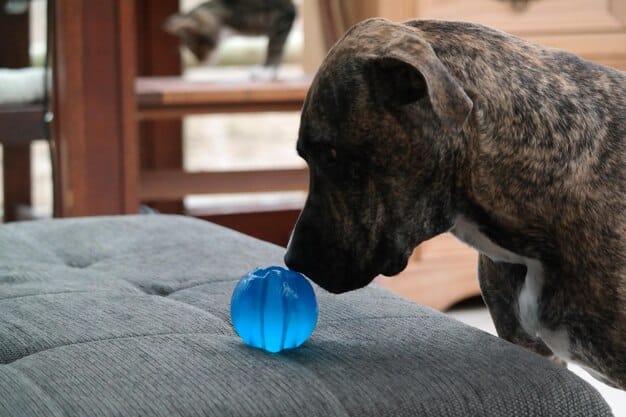
Teaching Bite Inhibition
Bite inhibition refers to a puppy’s ability to control the force of their bite. Teaching bite inhibition is crucial for ensuring that even if a puppy does bite, it won’t cause serious harm.
The “Ouch!” Method
When a puppy bites too hard during play, say “Ouch!” in a high-pitched voice. This mimics the sound a puppy would make when hurt during play, and it usually startles them.
Time-Outs
After saying “Ouch!”, immediately stop playing with the puppy. This shows them that biting results in the end of fun.
Redirection
Offer an appropriate chew toy instead of allowing the puppy to bite hands or clothing.
- Consistent Response: Using “Ouch!” every time ensures the puppy understands the boundary.
- Withdrawal of Attention: Time-outs should be brief, about 10-20 seconds, to be effective.
- Positive Reinforcement: Praise and reward the puppy when they choose to chew on a toy instead of biting.
Teaching bite inhibition involves consistent responses, time-outs, and redirection. By implementing these techniques, you can help your puppy learn to control the force of their bite, minimizing the risk of injury in the future.
Managing Play Biting
Play biting is a common behavior in puppies, but it’s essential to manage it effectively to prevent it from becoming a persistent issue. Here’s how to deal with play biting effectively:
Recognize the Signs
Learn to recognize the cues that indicate your puppy is about to start play biting. These may include excited barking, playful bowing, or nipping at your heels.
Provide Alternatives
Keep a variety of chew toys on hand to redirect your puppy’s biting urges. Rotate the toys regularly to keep them interesting.
Controlled Play Sessions
During play sessions, set clear boundaries and stop immediately if your puppy starts to bite too hard.
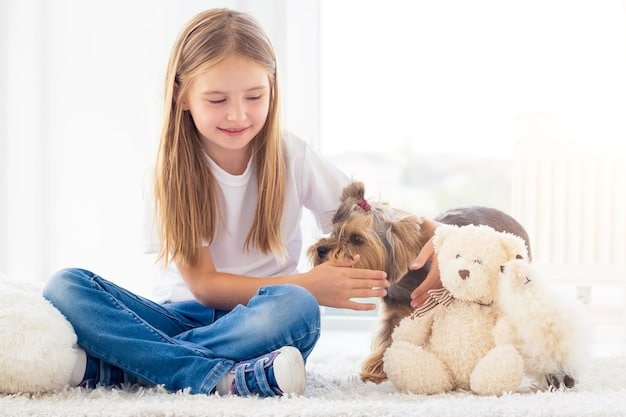
- Anticipate Biting: By recognizing behavioral cues, you can proactively prevent incidents.
- Diverse Toy Selection: A variety of textures and types can maintain the puppy’s engagement.
- Consistent Boundaries: Clear limits during play teach the puppy appropriate behavior.
Managing play biting effectively helps puppies establish good habits. By being proactive, providing alternatives, and setting clear boundaries during play, dog owners can guide the puppy toward more appropriate and less painful forms of interaction.
Dealing with Nipping and Mouthing
Nipping and mouthing are less intense forms of biting, but still need to be addressed to prevent them from escalating. Here’s how to handle nipping and mouthing:
Ignore Mild Mouthing
If mouthing is gentle and doesn’t cause pain, try ignoring the behavior. Often, puppies will stop if they don’t get a reaction.
Withdraw Attention
If mouthing becomes too persistent or starts to hurt, withdraw your attention immediately. This could mean turning away or leaving the room.
Teach “Leave It”
Train your puppy to respond to the command “Leave it.” This is particularly useful for preventing them from picking up and mouthing inappropriate items.
- Reactive Strategy: Ignoring gentle mouthing can discourage the behavior without being punitive.
- Consistent Message: Consistency is key to sending a clear behavioral message.
- Preventative Action: The “Leave it” command helps preventing undesirable mouthing habits.
Addressing nipping and mouthing behaviors head on will help the puppy learn appropriate interactions. Consistent reactions and clear guidelines reinforce positive behavior for a well-mannered puppy.
Creating a Safe Environment
A safe and stimulating environment can significantly reduce puppy biting by ensuring that the puppy’s needs are met. By providing appropriate outlets for their energy and curiosity, you can minimize unwanted behaviors.
Plenty of Toys
Ensure your puppy has a variety of toys to chew and play with. Rotate the toys regularly to keep them interesting.
Regular Exercise
Provide daily exercise to burn off excess energy. This can include walks, play sessions, or puzzle toys that challenge them mentally.
A bored and restless puppy is more likely to resort to biting as a way to entertain themselves or relieve frustration.
- Toy Rotation: Regularly rotate toys for engagement and excitement.
- Balanced Activities: Integrating exercise and puzzle toys for mental stimulation.
- Reducing Negative Behaviors: Well-stimulated puppies are less likely to bite out of boredom.
Creating a safe environment helps meet a puppy’s energy and curiosity leading to reduced behavior issues. Providing plenty of toys and regular exercise guarantees that the puppy’s needs are addressed, resulting in a happier and better-behaved companion.
When to Seek Professional Help
While most puppy biting can be managed with consistent training and patience, some situations may warrant professional help. It’s important to be able to recognize these situations to prevent future escalation.
Aggressive Biting
If the puppy is biting aggressively, showing signs of growling, snapping, or guarding resources, consult a professional trainer or behaviorist. This could indicate a more serious underlying issue.
Failure to Improve
If, despite consistent training efforts, the puppy’s biting behavior doesn’t improve, it’s time to seek expert advice. A professional can identify any underlying causes and provide a tailored training plan.
Anxiety or Fear
If the biting is triggered by anxiety or fear, a consultation with a vet or behaviorist may be necessary. Anxiety-related biting often requires a different approach than play biting.
- Underlying Issues: Professional consultation can help identify aggression concerns.
- Specialized Strategies: Expert guidance ensures effective approach when training methods fail.
- Specific Management: Professional assistance is crucial when managing anxiety and fear-based biting.
Consulting with professionals can lead to addressing underlying issues and implementing better training techniques. Recognizing such signs and seeking timely interventions ensures the puppy receives the appropriate care and guidance.
| Key Point | Brief Description |
|---|---|
| 🐾 Bite Inhibition | Teach puppy to control bite force with “Ouch!” and time-outs. |
| 🧸 Play Alternatives | Provide chew toys and controlled play sessions to redirect biting. |
| 🚫 Nipping Control | Ignore mild mouthing, withdraw attention if it hurts, teach “Leave it.” |
| 🏡 Safe Environment | Ensure plenty of toys and regular exercise to reduce biting. |
FAQ Section
▼
Puppies bite for many reasons, including teething, exploration, play, and sometimes due to fear or anxiety. Understanding the root cause helps in addressing the problem effectively.
▼
Use the “Ouch!” method when your puppy bites too hard, followed by a brief time-out. This helps them understand that biting too hard ends the play session.
▼
Provide a variety of chew toys that your puppy can bite instead of your hands or furniture. Rotate these toys to keep them engaging.
▼
If the biting is aggressive, doesn’t improve with training, or is triggered by anxiety or fear, consult a professional trainer or behaviorist.
▼
Early intervention is crucial. Addressing biting behavior early on prevents it from becoming a persistent and potentially dangerous habit as the dog grows older.
Conclusion
Dealing with puppy biting requires patience, consistency, and a clear understanding of why puppies bite. By implementing the strategies discussed—teaching bite inhibition, managing play and nipping, creating a stimulating environment, and seeking professional help when needed—you can effectively curb this behavior and nurture a well-behaved and loving companion.

